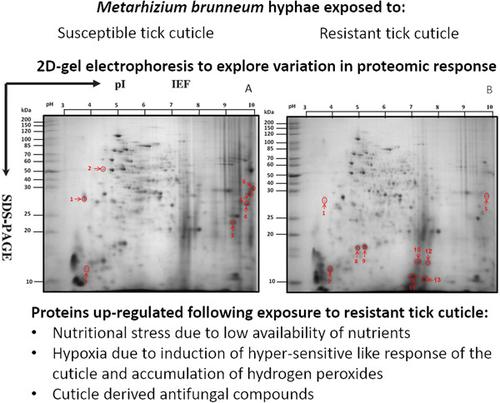当前位置:
X-MOL 学术
›
Arch. Insect Biochem. Physiol.
›
论文详情
Our official English website, www.x-mol.net, welcomes your
feedback! (Note: you will need to create a separate account there.)
Comparative response of Metarhizium brunneum to the cuticles of susceptible and resistant hosts
Archives of Insect Biochemistry and Physiology ( IF 1.5 ) Pub Date : 2020-11-02 , DOI: 10.1002/arch.21756 Dana Ment 1 , Galina Gindin 2 , Michael Samish 2, 3 , Itamar Glazer 2
Archives of Insect Biochemistry and Physiology ( IF 1.5 ) Pub Date : 2020-11-02 , DOI: 10.1002/arch.21756 Dana Ment 1 , Galina Gindin 2 , Michael Samish 2, 3 , Itamar Glazer 2
Affiliation

|
Earlier studies demonstrated that Metarhizium brunneum, usually a broad‐host pathogen of arthropods, is unable to complete its pathogenic life cycle when inoculated on the fungus‐resistant tick, Hyalomma excavatum engorged females. While the fungus penetrates the cuticle of fungus‐susceptible tick, Rhipicephalus annulatus females, it is unable to penetrate the cuticle of fungus‐resistant tick, and even perishes on its surface. This is probably due to high concentration of antifungal fatty acids and probably also due to a hypersensitive‐like response of the tick. To understand the metabolic pathways occurring in the fungal hyphae upon encountering the cuticles, we compared the response of the fungus to cuticle from susceptible and resistant tick cuticles by 2D‐gels. The intracellular proteomes of M. brunneum Mb7 exposed to cuticle of the fungus‐susceptible tick, R. annulatus, and to the fungus‐resistant tick, H. excavatum engorged females were compared after exposure to either cuticles. By means of liquid chromatography‐mass spectrometry/mass spectrometry we identified in both proteomes common proteins involved in biological processes as well as unique proteins identified only in the proteome of fungus exposed to fungus‐resistant tick cuticle. These proteins were identified in high probability as heat shock proteins, four key enzymes of the glyoxylate cycle, and proteins associated with hypoxia, and exposure to antifungal drugs. These findings are discussed within the M. brunneum‐tick pathosystem in relation to tick resistance and host resistance in general.
中文翻译:

根瘤菌对易感宿主和抗病宿主表皮的比较反应
较早的研究表明,通常在节肢动物中广泛传播的病原体布鲁氏杆菌接种到抗真菌的tick虫上,透明质酸充满了雌性,无法完成其致病性生命周期。当真菌穿透真菌敏感tick的角质层时,Rhipicephalus annulatus雌性,它不能穿透抗真菌tick的角质层,甚至在其表面上消失。这可能是由于高浓度的抗真菌脂肪酸,也可能是由于壁虱的过敏反应。为了了解遇到表皮后真菌菌丝中发生的代谢途径,我们比较了2D凝胶对真菌对敏感和抗性cut角质层的响应。的细胞内蛋白质组M. brunneum MB7暴露于真菌敏感蜱,角质层R. annulatus,并以抗真菌蜱,H. excavatum接触任一表皮后,比较饱腹的女性。通过液相色谱-质谱/质谱,我们在蛋白质组中鉴定出了与生物学过程有关的常见蛋白质,以及仅在暴露于抗真菌壁虱的真菌蛋白质组中鉴定出的独特蛋白质。这些蛋白质极有可能被鉴定为热休克蛋白质,乙醛酸循环的四个关键酶,以及与缺氧和暴露于抗真菌药物有关的蛋白质。这些发现中所讨论的M. brunneum相-TICK病害系统剔性和宿主抗性一般。
更新日期:2020-11-16
中文翻译:

根瘤菌对易感宿主和抗病宿主表皮的比较反应
较早的研究表明,通常在节肢动物中广泛传播的病原体布鲁氏杆菌接种到抗真菌的tick虫上,透明质酸充满了雌性,无法完成其致病性生命周期。当真菌穿透真菌敏感tick的角质层时,Rhipicephalus annulatus雌性,它不能穿透抗真菌tick的角质层,甚至在其表面上消失。这可能是由于高浓度的抗真菌脂肪酸,也可能是由于壁虱的过敏反应。为了了解遇到表皮后真菌菌丝中发生的代谢途径,我们比较了2D凝胶对真菌对敏感和抗性cut角质层的响应。的细胞内蛋白质组M. brunneum MB7暴露于真菌敏感蜱,角质层R. annulatus,并以抗真菌蜱,H. excavatum接触任一表皮后,比较饱腹的女性。通过液相色谱-质谱/质谱,我们在蛋白质组中鉴定出了与生物学过程有关的常见蛋白质,以及仅在暴露于抗真菌壁虱的真菌蛋白质组中鉴定出的独特蛋白质。这些蛋白质极有可能被鉴定为热休克蛋白质,乙醛酸循环的四个关键酶,以及与缺氧和暴露于抗真菌药物有关的蛋白质。这些发现中所讨论的M. brunneum相-TICK病害系统剔性和宿主抗性一般。











































 京公网安备 11010802027423号
京公网安备 11010802027423号